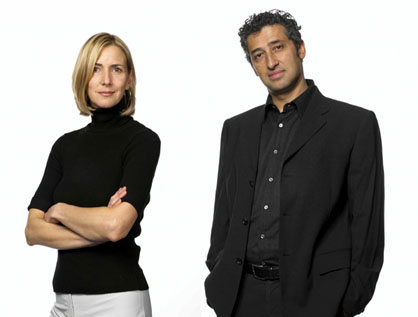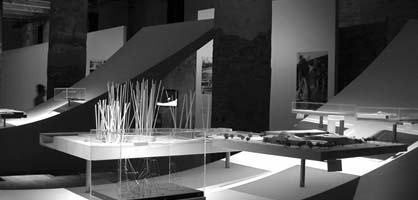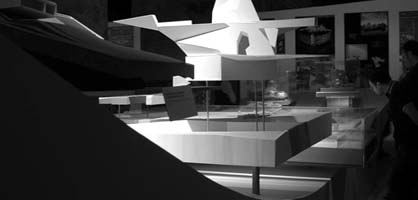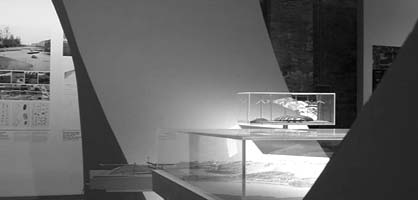|
|
| home > files |
| Interview
with Hani Rashid Luca Molinari |
The
program of this year's Venice architecture biennale, curated by Kurt
W. Forster, will be articulated, as usual, in two distinct environments:
the Giardini and the Arsenale. Asymptote's complete engagement in the
exhibition -from installation and exhibition design to graphic identity
and catalogue design (with Omnivore)- provides for a seamless experience
and a spatially cohesive backdrop to the curator's theme METAMORPH.
Especially striking and engaging is Asymptote's complete transformation
of the enfilade of longitudinal spaces in the Arsenale into a modulating
terrain on which over 220 projects are exhibited with models, drawings
and video installations. The computer generated morphing animation sequence
used to conceive the stage in the Arsenale was derived from combining
perspectival geometry with the actions of torquing and stringing. Far
from offering an unfriendly and solely geometrical experience, the stage
for the Arsenale's discursive exposition is highly captivating for the
visitor, and spatially it is a lot more stimulating and pleasing than
what the renderings and wireframes already anticipate. ARCH'IT presents,
in the words of New York based Asymptote, the
project for the exhibit design of the Biennale. Hani Rashid's sharp
and energetic answers to Luca Molinari's interview further explain the
design concept. [PG] |
||||
|
LUCA MOLINARI: Every architect dreams of working inside the Biennale
of Venice. What does it mean for you and within your creative path? HANI RASHID: Yes, it has been a remarkable opportunity. I have watched each architecture biennale with envy and unabashed curiosity and have always paid close attention to what architects such as Hans Hollein, Aldo Rossi, Paolo Portoghesi and most recently Massimiliano Fuksas had done with these spaces. For us this is an amazing legacy in which to work and we took the challenge by the horns so to speak. The added provocation here was to work along side Kurt Forster who is not an architect but has a curious and I would say encyclopedic mind. The challenge being to meet Mr. Forster's idea for a biennale with an equally compelling spatial vision and iterations and in this way rather than it being a two headed beast, we end up with a powerful singular vision.  My immediate impulse was to work with the perspective and magical aspects of the Corderie and Giardini. The first thoughts were of the immense strands of rope that were twisted and strewn through the spaces of the Corderie in the Arsenale when in the past centuries battle and merchant ships were prepared and outfitted here. From this visceral and intuitive response we started to work on computer generated forms and animations, morphologies and topologies to create an undulating, sinewy terrain on which to 'display' architects works in a strategy more akin to a museum of natural sciences and history rather than the always dangerous trade show like atmosphere that these shows can easily become. The computer 'sketching', though essentially animations, led us to develop the curved part boat part bridge part seascape part abstract sculpture elements that we have integrated into and throughout the entire space of the Corderie. I recalled often through the design process one of my favorite scenographies in film, that of Federico Fellini's Venice in his great film Casanova, where Fellini shot all the Grand Canal footage in the soundstages of Cinecittą in rooms covered in air filled plastic bags that though pumping and evacuating air he simulated the liquid terrain of the Venetian waterways. I loved that image and wanted to evoke that sense of instability and movement in the Arsenale and Giardini.  For us the chance to build in these magnificent places is very much in line with the Asymptote approach to all our works where there is the chance to play of the real against the virtual (3dtf nyse gvm), utility and vision (knoll a3), phenomena and plasticity (hydrapier) and explorations into computer generated formal and manufacturing possibilities (Miele, BMW, Mercedes). Which were your sensations and suggestions working in-between the Arsenale and the pavillons? |
[13sep2004] | |||
| For
the Giardini the idea of promoting and instigating a new terrain was
more minimal and sculptural as well as practical. I always find the
Biennale arduous and so the intention was to provide really the world's
longest, and perhaps most elegant, bench, part seating, part skateboard
ramp, part sculpture. This 'red' rope-like element stretches from the
water's edge to the front of the Italian Pavilion and serves as a kind
of linear beacon tying together all the pavilions along the main stretch
visually and spatially. On a practical level I foresee people using
it to 'chill' between pavilions, to sit, look and perhaps even chat
with each other (in realtime), a kind of piazza as a line. And how did you consider and use those spaces in relation to your work? The notion of tying together the Giardini and 'splitting' the perspective of the Corderie were the two main interests formally and architecturally. In other words a defiance of perspectival geometry, symmetry and linearity in one place, while an enforcement and celebration of space and geometry in the other.  What does it mean for you to show architecture today? Architecture today is in a state of extreme flux, we are at the end of modernity as we knew it and at the threshold of something else, something not yet certain. And I am an adamant disbeliever in 'blobs' or any other stylistic genre by the way. Rather I am convinced the digital is helping pave the way to entirely new ways of thinking about architecture and spatial concerns, Interactivity, computer aided manufacturing, unknown geometric, formal and engineering capabilities and possibilities and many other aspects in contemporary culture and thinking are pushing us away from the certainty of the modern. To show this flux two things were required: Kurt's complicated and thorough curiosity and Asymptote's ability to play along spatial and technological lines, yielding an exhibition of extraordinary breadth, perplexity. In the end it problematizes the situation as opposed to clarifying it or attempting to do so as say NEXT did two years ago, a defiance of what was in my mind, an utterly boring trade show like exhibition of big expensive works and sample boards by well known architects. |
||||
| Tell
me about your relationship with Italy. Italy has always been for me the place of absolute reconciliation, philosophically and viscerally. I was born in Cairo as you know, to an Egyptian father who was a great painter, sculpture and stage set designer, and a British mother who was an English teacher at the time. Together they formed a very 'modern' family and moved to Rome in the early 60's. I think because of my earliest memories of Rome I have always seen Italy as the place where the extremes of my heritage came together and formed a unity of sorts. Somehow the power and beauty of my father's culture, who spent a great deal of time studying ancient Egyptian antiquities and culture to form his interests in modern art, and eventually won the Rome Prize and was celebrated at the Venice Biennale in 1958 as a painter, and my mother's literary background and British (Western) culture seemed all to blend seamlessly in the space of Rome, from Trastevere to the Roman Forum. Later, after finishing graduate school in the US I moved immediately to Milan where I actually initiated Asymptote with a group of people from around Europe and Milan. The group started as an intellectual foray into architecture spending most of our time writing theory and producing unbuildable ideas out of my garret space in via Circo. Lise Anne and I also spent a year in Rome studying where we actually became an a couple and have been one ever since. At the moment I am writing this on my laptop in our Italian home in La Marche (a 500 year old priest's house) near Urbino with our 7 year old son next to me reading his novel and in his own way beginning to reconcile his even more extraordinary cultural mix here in the magnificence of the Italian landscape.  |
||||
| How
did you carry on this particular work? I know you partially did it in
your Italian home. Yes we worked on the Biennale from both our New York studio, where all the models, drawings and technical specification came from, and from the Italian base dealing with the day to day issues as well as the conceptual ideas. Somehow being in Italy allowed us to work through much of the political hurdles and social differences that we are used to in the American situation. I believe that Lise Anne and my Italian situation helped us a great deal with working with La Biennale, which as you might imagine is a fascinatingly complex organism. Which questions and goals came from Kurt Forster? Kurt really had no questions of mandates of us, he simply gave us free reign to devise a strong and outstanding Biennale for him to operate within. We provided what we called a 'canvas' on which Kurt could 'paint' a Biennale. And I believe it was a very successful strategy. The only real difficulties emerged with Kurt's appointed assistants whom I believe were very naive and somewhat inexperienced, and we spent far too much energy dealing with them on minor issues. Over all however Kurt maintained control, despite the rampant ego mud slinging around him, and we in the end worked with him extremely well.  Which are the other ongoing project of Asymptote and are there any links with the Venetian project? Forster brought to Venice two of our projects to exhibit at the Biennale: the BMW event and delivery center exhibited in the section "surfaces", and a project we are now moving into construction in Holland for a Crematorium in Sheidam. This project being the latest on the boards has a great deal of affinities to the formal strategies we employed in the Biennale installations. It is a large scale project that resulted from a study of flows, movement of surfaces and topologies and resulted in a very pristine and elegant formal approach for such a strong program as it will obviously contain and accommodate. We are also master planning a very large scale new city in Malaysia, working on a product line for Alessi (again my Italian obsession), building a large tensile structure in Odense, Denmark to commemorate the 200th anniversary of Hans Christian Anderson, and lastly producing a series of furniture pieces for the art collector Simon De Pury. |
||||
|
Part of this interview has already been published on VANITY FAIR Italia. |
||||
|
>
LA BIENNALE DI VENEZIA |
||||